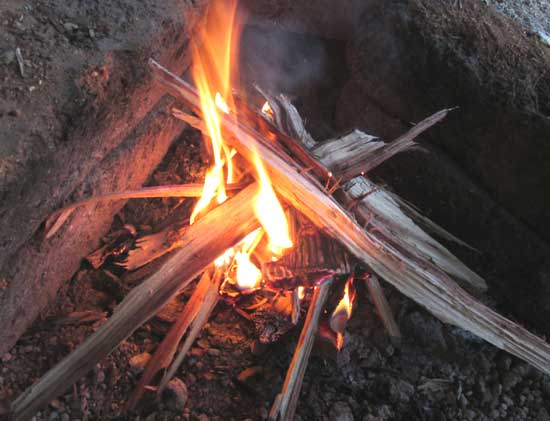Excerpts from Jim Conrad's
Naturalist Newsletter
from the February 12, 2017 Newsletter issued from Rancho Regensis north of Valladolid, Yucatán, MÉXICO
HOW TO BUILD A CAMPFIRE This is especially for those in the future dystopia who may need a small fire, but who may lack commercial fire starters and properly cured firewood, and may have no idea where to start.
If you have a pot with a wire handle atop it, you can build your fire beneath a tripod, with the pot suspended over the fire. If you have a skillet, something like a wire rack from an abandoned refrigerator can be positioned atop the rocks, and the fire built beneath the skillet resting on the rack. My current morning campfires are like the latter, except that I'm using homemade adobe blocks instead of three rocks, as shown below:

For building campfires, nothing is more important than this:
Understand how campfires function so you can use whatever fuel is at hand to build them, under many different conditions.
Fire feeds on oxygen in the air, so air should have easy access to your fuel. As you arrange your fuel, visualize the fire heating up the air, which rises above the flames, sucking in more air from the sides. My current campfires with three sides closed by adobe bricks has air rushing in from the open side, so the fuel is arranged so that air can freely pass into the fire's heart.
Unless your fuel is saturated with some kind of easily inflammable substance, such as the resin in pine wood, you can't just put a match to a large item and expect it to burn -- not even large pieces of dry, well cured wood. You should begin with a small heap of thin pieces of fuel, like wood shavings, small twigs, shreds of paper or dry leaves.
My first step in building a fire usually is to place on the ground in the future fire's center something about the size of an egg, maybe an unburned hunk of charcoal from a past fire, around which I build a little teepee of elongated pieces of easy-to-ignite fuel, usually shavings and slivers of wood. Over this highly combustible teepee I position slightly larger pieces of fuel, more or less continuing with the teepee strategy, but making sure I'm not blocking air access, or my own access to the interior with a match. Below, you can see a campfire at the moment when its interior teepee, partly composed of dry cardboard, has just caught fire but the larger pieces haven't:

At this point, if you intend to keep the campfire burning for a long time, you can arrange larger sticks so that each one has a burning end in the fire. As the sticks convert to ash, you can keep nudging them toward the center, replenishing the fuel there.
Your luck in starting the fire depends very much on what kind of fuel you've gathered. Old tree twigs and splinters of wood that have absorbed humidity may not want to burn, even if their surfaces are dry. Especially during rainy seasons when the air is especially humid, if at all possible prepare for your campfires by storing dry fuel in sheltered places. If you don't have a shelter, cover dry fuel with a plastic sheet and secure the sides. At the peak of our rainy season, even apparently dry paper doesn't want to burn.
If you really need a fire and have trouble getting it going, you might consider adding a bit of plastic to it -- trash plastic being omnipresent in the future dystopic landscape. Burning plastic releases chemicals you don't want coming in contact with your water and food but, if you're desperate, a little plastic amid more desirable fuel can get most uncooperative campfires going. As plastic melts, it drips its highly inflammable, oil-like petrochemical base onto your fire, feeding it. Sometimes as a plastic source I've used the thin, transparent plastic of bottles in which purified water is sold.
Once you've finished with a campfire, remember that the embers can smolder flamelessly for a long time, being a fire hazard. Scattering the fire's remaining coals and dousing them with water or covering them thoroughly with dirt may be a good idea.
To get you more into the campfire mood, you might be interested in our essay Morning Campfire at https://www.backyardnature.net/n/p/160117.htm and Campfires & the Middle Path at https://www.backyardnature.net/n/p/100530.htm